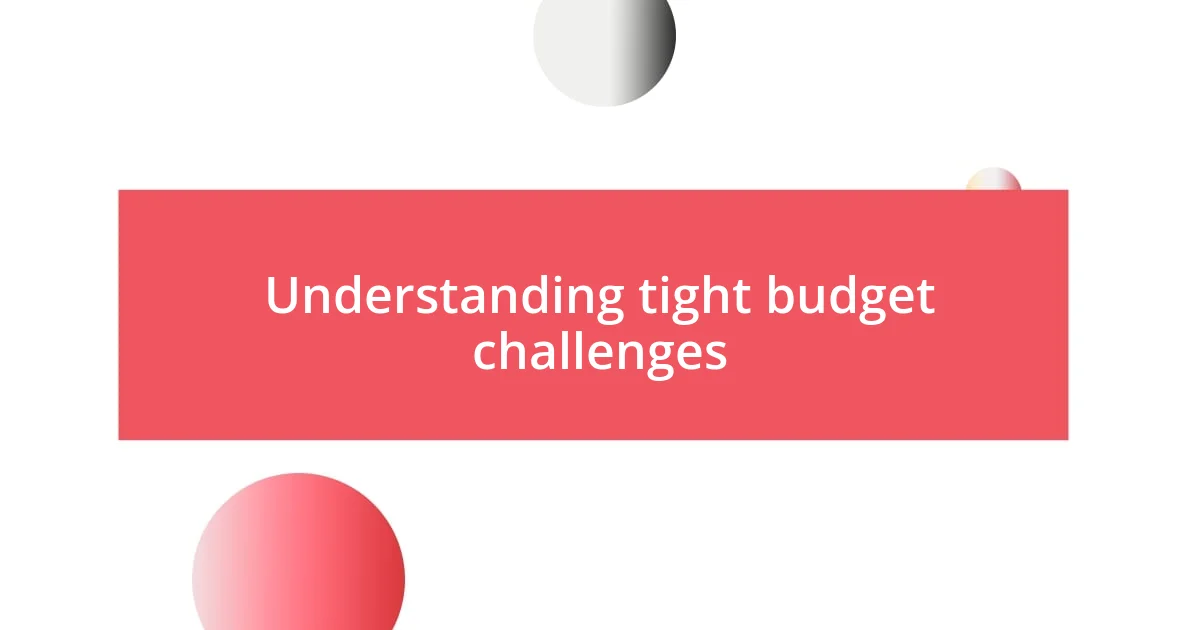Key takeaways:
- Living on a tight budget requires creative solutions such as skill swapping and strategic decision-making to balance wants and needs.
- Effective budgeting techniques, like the envelope system and the 50/30/20 rule, help manage finances and promote accountability.
- Thrifting and maximizing free resources, such as libraries and community events, not only save money but also foster community connections and sustainability.

Understanding tight budget challenges
Living on a tight budget can often feel like walking a tightrope. One misstep, like an unexpected car repair, can send your financial plans tumbling down. I remember a time when my laptop decided to give up on me right before a big project was due. That experience taught me how quickly a small emergency can disrupt my carefully crafted budget.
Navigating through the monthly bills while still trying to save can evoke a mix of anxiety and frustration. I often find myself questioning how to balance wants with needs, especially when those little treats, like a coffee run or a new book, start to add up. It’s almost like playing a strategic game: do I indulge today, or save for a more significant goal tomorrow?
I’ve realized that these budgetary challenges often lead to creative solutions. For instance, I started swapping skills with friends instead of paying for services. Why pay for a haircut when I can trade a homemade meal? This not only helps me stretch my dollars but also nurtures relationships, reminding me that community can be just as valuable as cash.

Effective budgeting techniques to consider
One effective technique I’ve found is using the envelope system. By allocating specific amounts of cash for different spending categories, I can visualize where my money goes and avoid overspending. For instance, I’ll set aside a predetermined amount for groceries, entertainment, and dining out. This method not only keeps me accountable but also provides a tangible way to manage my finances that feels less abstract than digital transactions.
Another strategy that resonates with me is the 50/30/20 rule. This budgeting method divides your after-tax income into three categories: 50% for needs, 30% for wants, and 20% for savings. I’ve followed this approach for a while, and it simplifies my decision-making process. If I ever feel tempted to splurge, I can quickly check if my wants category can handle it without impacting my savings or essential expenses.
Finally, tracking my spending habits through a budgeting app has been a game-changer. I started using an app to categorize my expenses, and it has opened my eyes to patterns I hadn’t noticed before. Were those impulse buys at the local coffee shop really worth it? By seeing my spending in black and white, I can make informed decisions to cut back where necessary, aligning my day-to-day actions with my financial goals.
| Budgeting Technique | Description |
|---|---|
| Envelope System | Allocates cash to specific spending categories to control overspending. |
| 50/30/20 Rule | Divides income into needs, wants, and savings for easier decision-making. |
| Budgeting App | Tracks expenses to identify patterns and make informed spending decisions. |

Smart shopping strategies for savings
Smart shopping strategies can be a real lifesaver when you’re trying to stretch your budget. I remember when I was looking to refresh my wardrobe but didn’t want to break the bank. Instead of hitting the retail stores, I discovered thrifting. It was like a treasure hunt; each visit produced unexpected gems that not only saved me money but also sparked joy in the finding. Using sites like Poshmark or eBay has been equally rewarding, allowing me to buy gently used items at a fraction of the original price.
Here are some smart shopping strategies that have worked for me:
- Create a shopping list: Sticking to a list minimizes impulse buys and keeps your spending focused.
- Use coupons and cashback apps: Savings can stack up quickly with these tools; I often find discounts on products I already intended to buy.
- Buy off-season: For example, purchasing winter clothes in spring can save you significant money. I found a beautiful coat last summer at 70% off just because it wasn’t the right season!
- Consider generic brands: I’ve swapped out name-brand items for store brands, and honestly, many of them taste just as good—sometimes even better.
- Plan your meals: I plan my week’s meals around sale items and use what I buy, reducing food waste and helping my wallet.
I’ve learned over time that every little saving adds up, and these strategies not only ease my financial burden but also make shopping an enjoyable challenge.

Affordable meal planning ideas
When it comes to affordable meal planning, I’ve discovered that simplicity is key. One technique I rely on is creating a meal plan based on what’s on sale at the grocery store each week. It’s almost like a game; I scan the flyers for deals, and then I think, “What meals can I whip up with these ingredients?” It not only keeps my costs down, but it also sparks creativity in the kitchen.
I also love batch cooking—honestly, it’s a lifesaver. On weekends, I dedicate a few hours to cook large portions of meals that I can freeze or store for later in the week. For instance, I make a giant pot of chili or a hearty vegetable soup. When I’m busy during the week, I just grab a container, heat it up, and I’m good to go. It’s comforting to know I’ve got tasty meals ready that won’t force me to spend money on takeout.
Lastly, I can’t stress enough the importance of embracing versatile ingredients. I often buy staples like rice, beans, and seasonal produce, which I can mix and match throughout the week. Have you noticed how one ingredient can transform a dish? For example, using quinoa as a base, I can throw in leftovers from the week, maybe some sautéed veggies or grilled chicken, and create something delicious while minimizing waste. It’s a fun challenge that always ends up a win for my budget!

Thrifting and secondhand shopping benefits
Thrifting and secondhand shopping have become my go-to strategies for not just saving money but also finding unique pieces that tell a story. I remember the thrill of scoring a vintage leather jacket for less than a dinner out. Each time I explore a thrift shop, it feels like stepping into a world of possibilities where I can find not just clothing, but also furniture and home decor that add character to my space. Isn’t it fascinating how a secondhand item can have so much more personality than a mass-produced piece?
Another benefit I’ve noticed is the sustainability factor. Buying secondhand helps reduce waste and supports a more eco-friendly lifestyle. When I choose to shop thrifty, I’m not only saving my budget but also contributing to a circular economy where items are reused and cherished by new owners. I often think about how the decisions I make at the thrift store echo broader environmental impacts. It’s a win-win—saving money and caring for our planet!
The community aspect is also something I cherish about thrifting. I’ve met wonderful people who share my passion for finding hidden treasures. I remember chatting with a fellow treasure hunter while combing through the racks, and we bonded over our shared excitement when we both unearthed similar finds. These interactions make the experience much more enjoyable and enrich my understanding of fashion and style. Have you ever experienced that sense of camaraderie while shopping? It’s moments like those that remind me why I truly love thrifting.

Maximizing free resources and opportunities
When it comes to maximizing free resources, I’ve found that local public libraries are a treasure trove. Think about it: not only can you check out books, but many libraries also offer free workshops, community events, and access to online resources like streaming services and eBooks. I remember stumbling upon a free cooking class at my library, which not only taught me new recipes but also connected me with others in my community. Have you considered all the valuable experiences waiting for you at your local library?
I also love using community bulletin boards and social media groups to seek out free events or resources. Just the other day, I discovered a local park hosting free yoga classes on Saturday mornings. It was a delightful surprise and a great way to incorporate wellness into my weekend without breaking the bank. Finding opportunities like this makes me wonder—what other hidden gems could be awaiting you in your neighborhood?
Additionally, I truly believe in the power of networking—especially when it comes to skills swapping. I once traded my graphic design skills for a friend’s guitar lessons, and it turned into a rewarding experience for both of us. By using what you already know and sharing it with others, you can create a community where everyone benefits from each other’s strengths. Isn’t it empowering to think about how much we can learn without spending a dime?















